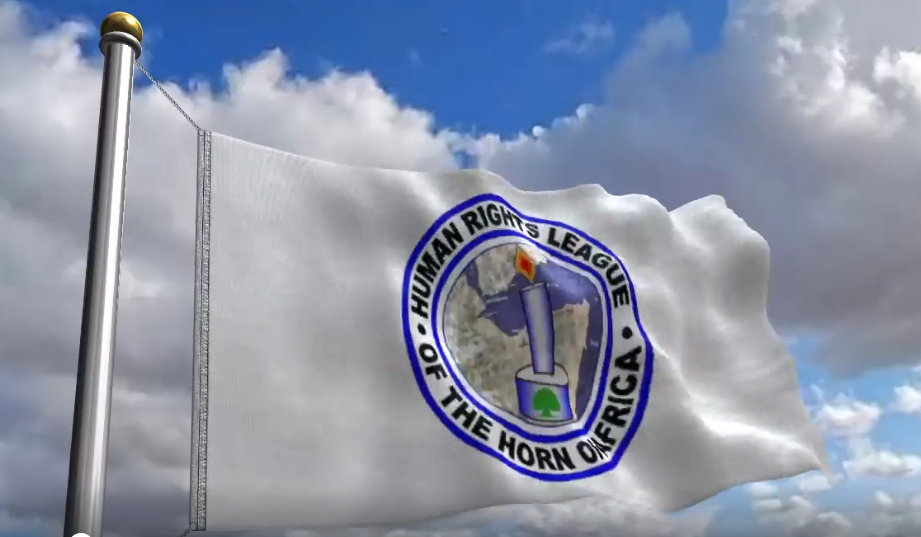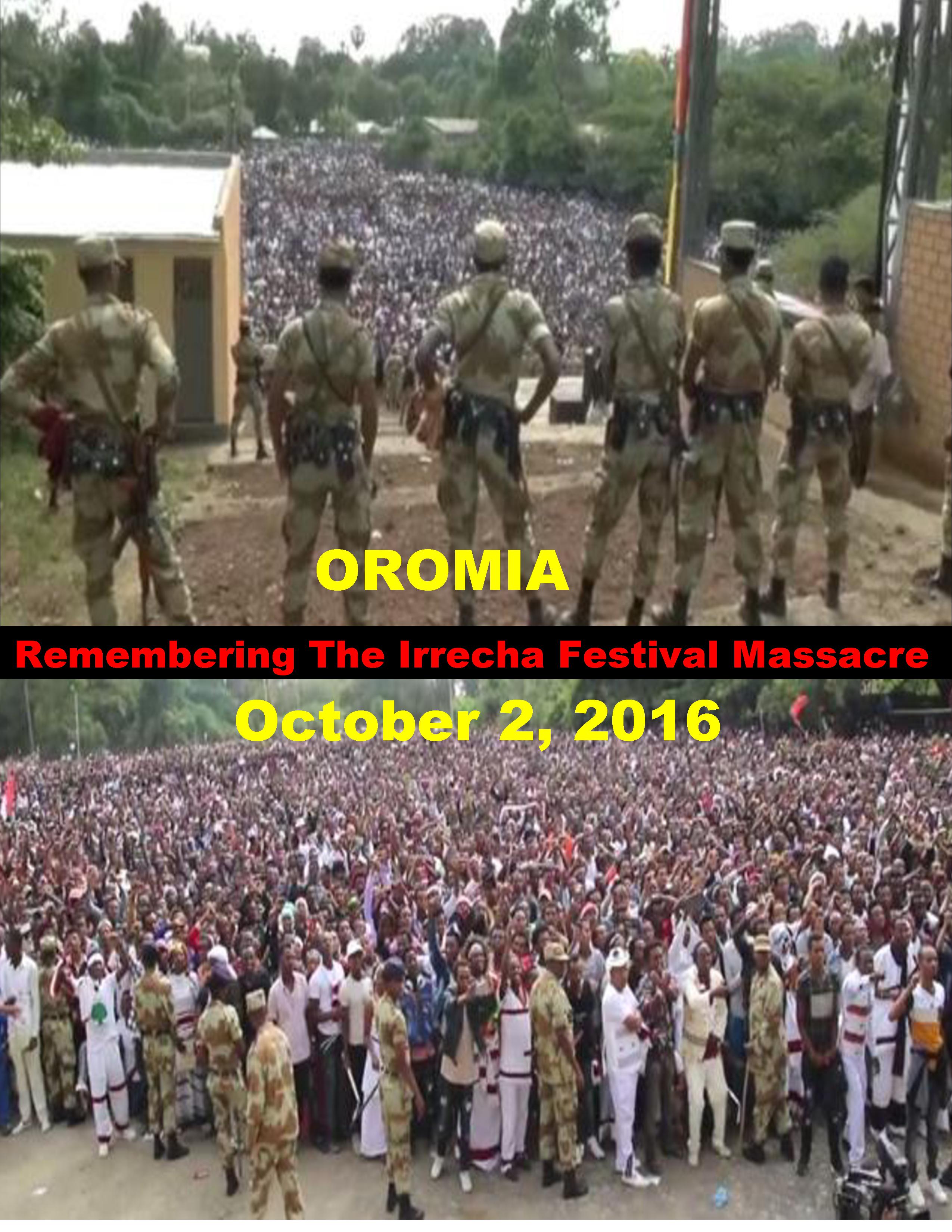Sep 24, 2017
October 2, 2016, is recognized by the Oromo nation as one of the blackest days in Oromo history. It was different from all past tragedies committed against Oromos by previous Ethiopian regimes. The October victims were innocent Oromos who came to gather from all Oromia zones, and traveled hundreds of kilometers to attend the annual Irrecha Festival celebration at Hora Arsedii, Bihoftuu. Celebrating the Irrecha Festival, the Oromo Thanksgiving day, with Oromos of all ages is not only a joy, but it is a special event where Oromos renew their attachment to their God ” Waaqaa” and get together and strengthen their nationhood. In the Irrecha Festival, particular songs and dances are performed by boys, girls, elders and children.
In the years before October 2, 2016, the Irrecha Festival was a time during which the Oromo nation continuously demonstrated for decades against the regime to express their grievances against suppression and marginalization, demanding freedom and justice. Protests in Oromia zones initially flared in 2014 over the so-called “Addis Ababa Master Plan,” a development plan for the capital that would have expanded its boundaries annexing 36 Oromia towns and evicting over two million Oromos from their ancestral lands.
The TPLF/EPRDF regime replied to the demands of the people by killing, kidnapping and arresting Oromos. From 2014 to 2016, in Oromo demonstrations over 2500 Oromos have been killed and another several thousand detained and disappeared by the regime forces. The Irrecha Festival of October 2, 2016 celebration took place after all these brutalities against the Oromo nation had been committed by the TPLF/EPRDF regime. At the 2016 Irrecha Festival, over two million people gathered and chanted “We need Freedom, We need justice.”
In response, military forces fired tear gas and the guns into crowds, and the crowds stampeded. The military continued firing weapons on the ground and from the air, killing over 700; hundreds more were injured, some of them thrown into a deep ditch.
The Human Rights League of the Horn of Africa documented the tragedy at the Irrecha Festival on October 2, 2016 . The HRLHA gave its followers evidence that shows the massacre at the Irrecha Festival on October 2, 2016, was a pre-planned and deliberate attack perpetrated against the Oromo people by the TPLF/EPRDF regime.
Oromo Radio and TV Journalists Eyewitness of Irrecha Festival Massacre
The cruelty of the Ethiopian regime in which thousands of Oromos have been cold-bloodedly murdered by the killing squad Agazi force during the peaceful protests in the past two-plus years has hurt the heart of the Oromo nation so badly. Though many Oromos were killed and others injured in the past over two and half years (2014 to 2016), still Oromos didn’t stop demanding from the government freedom and justice. The Federal and Oromia Regional governments were looking for any excuse to silence the uprising. Both government authorities knew that the Oromos could continue raising their grievances on the annual Irrecha Festival Thanksgiving celebration day (October 2, 2016). To crush the uprising, the government began by sending spies to all zones of Oromia and collecting information. “Qeerro Bilisummaa,” the Oromo youth Freedom organization members were the target of the government military force.
To confront any anti-government activity of Oromos, the federal government deployed heavily armed military forces to Bishoftu a day ahead of the start of the event.
On the eve of the Irrecha Festival, on Oct 1, 2016, several Oromos with colorful cultural clothes poured into the small town of Bishoftu- population of about 105000- from all directions and crowded the town with about two million irrecha Festival celebrants. The Office of Abba Gadaa in Bishooftu was full of people, especially youth members. Oromo children who were staying in Abba Gadaa’s office overnight chanted freedom slogans all night. Federal government military forces surrounded the office, and many youths were beaten, many injured by military and others were detained.
On Oct 2, 2016, early in the morning, people started grouping together for the journey to the Hora Arsadi; they sang inspirational songs mixed with grievance slogans. The protest slogans echoed by all groups included “Dinne, .. Dinne, .. Dinne” literally, in English translation means No, .. No,. No.
After reaching their destination, they continued echoing the slogans “Dinne,.. Dinne..”. The unarmed Oromia police tried to stop the groups from echoing the slogans while the federal military force started taking strategic positions and waiting for higher officers’ commands. As the Abba Gada’s blessing time approached, the time when the Thanksgiving event was to begin, the protesters’ voices became louder and louder. For some unknown reason, the expected Abba Gadaa of the year, Abba Gada Bayanaa Sanbatuu, didn’t appear on time to announce the opening ceremony and instead the X-Abba Gadaa, Aba Gada Laggasaa Nagawoo took the stage to announce it. As X-Abba Gadaa, Abba Gadaa Lagos Nagawoo took the microphone to speak to the crowd, loud voices “No, No” rocked the area.
The stage of the ceremony and the temporary studio for Oromo Radio and TV were in the same area surrounded by heavily armed military forces, and all journalists of different media had an opportunity to witness all movements through their cameras.
As security on the ground became more intense, a military helicopter came from an unknown direction and started to fly over the crowd dropping leaflets on the festival. A loud voice from the celebrants started coming from the direction where the helicopter was dropping the leaflets on the crowd. Some people from around the stage, including the X-Abba Gadaa, Abba Gadaa Laggasaa tried to take the microphone to calm the people.
Suddenly, from nowhere a teenager showed up and grabbed the microphone quickly and loudly echoed “DOWN, DOWN WAYYAANE!!, DOWN DOWN WAYANE!!”. The slogan was repeated by the crowd, many times for a few minutes.
The time was around 10 am, and we were ordered by military officers to evacuate the area immediately. We insisted that we would not abandon our duty and didn’t comply with the military orders. Again, one of the officers approached us and said “after this minute we are not responsible for anything happening to you, the crowd could come and take any action against you, you must leave this area quickly now!” said the officer with anger and a loud voice. The military commander in charge gave an evacuation order to all journalists- international and local- recording the event.
As we finished collecting our instruments, we were loaded on the truck and ordered to leave the area. We didn’t go far after we left our designated area. Quickly the military dispersed tear gas into the crowd from the air and ground. The group left. Many were running; others could not move because of the tear gas and fell. While the crowd was running, the military intensified its random shooting from the ground and the air.
The Irrecha Festival area was turned into a war zone. The military continued random shooting, the snipers on the backs of military vehicles fired deep into the crowd and killed some people, everyone was screaming, the Irrecha festival field was suddenly turned into a killing zone.
About Irrecha Festival
Irreecha (Afaan Oromo), also called Irreessa, is a Thanksgiving holiday of the Oromo nation in Ethiopia. The Oromo nation celebrate Irreecha to thank its Waaqaa (God) for the blessings and mercies they have received throughout the previous year. The thanksgiving is celebrated on the sacred grounds of Hora Harsadi (Lake Harsadi) ,Bishoftu Ormia 40 km south -east of the capital city, Finfinne (Addis Ababa). The Irreecha festival is celebrated every year at the beginning of Birraa (Spring), the new season after the dark and rainy winter season. Irrecha is celebrated in other parts of Oromia zones and around the world where diaspora Oromos gather around the globe.
The Oromo nation considers the winter rainy season from June to September as the time of difficulty. The heavy rain brings with it lots of things like swelling rivers and floods that may drown people, cattle, crops, and flood homes. Also, family relationships will be severely affected during winter rains as they can’t visit each other because of swelling rivers. In addition, winter time could be a time of hunger for some because of the fact that the previous harvest collected in January is running short and the new harvest is not ripe yet. Because of this, some families may endure food shortages during the winter. In Birraa (Spring in Oromoland), this shortage ends as many crops, especially barley and maize, ripen and families can eat their fill.
The Oromo nation celebrates Irreecha not only to thank Waaqa (God) but also to welcome the new season of plentiful harvests after the dark and rainy winter season. On Irreecha festivals, friends, family, and relatives gather together and celebrate with joy and happiness. Irreecha festivals bring people closer to each other and make social bonds.
Moreover, the Oromo nation celebrates this auspicious event to mark the end of the rainy season known as Ganna; this was a tradition established by their Oromo forefathers, in the time of Gadaa Melbaa in Mormor, Oromia. The auspicious day on which this last Mormor Day of Gadaa Melbaa – the Dark Time of starvation and hunger- was established was on the Sunday of the last week of September or the Sunday of the 1st week of October. All this is according to the Gadaa lunar calendar; the date is now known as National Thanksgiving Day by the modern-day Oromo nation.

